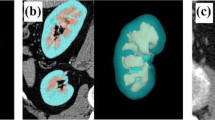Abstract
Background
Accurate assessment of pre-transplant split renal function in candidates for living kidney donation is indispensable for side-selection and a sufficient long-term residual renal function.
Objective
To analyse the need of depth correction in the assessment of split renal function in potential living kidney donors.
Methods
In 13 consecutive patients screened for living kidney donation split renal function was measured with four different methods including conventional posterior MAG-3-scintigraphy, the geometric mean method in MAG-3-scintigraphy, MAG-3-scintigraphy with CT-based depth correction and CT-volumetry. Correlation and agreement of methods were analyzed using Spearman’s rho correlation coefficient and the Bland–Altman method.
Results
Despite good correlation and agreement between the different radioisotopic methods there were clinically relevant differences in split renal function in 2/13 patients (15 %) between conventional posterior MAG-3 scan and the geometric mean method. The best correlation was found between the two scintigraphic methods with depth correction. Comparing radioisotopic methods with CT-volumetry, significant differences were found in up to 6/13 patients (46 %).
Conclusions
Our results clearly indicate that in the case of living kidney donation further assessment concerning the accuracy and reliability of measuring split renal function is necessary. As there are no differences in duration of examination, costs and radiation exposure between techniques with and without depth correction, but clinically relevant differences in up to 46 % of patients, kidney depth should be incorporated in daily clinical practice of living kidney donor evaluation. The geometric mean method could significantly improve future patient assessment in cases of living kidney donation.







Similar content being viewed by others

References
Halleck F, Diederichs G, Koehlitz T et al (2013) Volume matters: CT-based renal cortex volume measurement in the evaluation of living kidney donors. Transpl Int 26(12):1208–1216
Fleming JS (2006) A technique for analysis of geometric mean renography. Nucl Med Commun 27:701–708
Wujanto R, Lawson RS, Prescott MC, Testa HJ (1987) The importance of using anterior and posterior views in the calculation of differential renal function using 99mTc-DMSA. Br. J. Radio. 160:869–872
Prigent A (1999) Consensus report on quality control of quantitative measurements of renal function obtained from the renogram: international Consensus Committee from the Scientific Committee of Radionuclides in Nephrourology. Semin Nucl Med 29(2):146–159
Yapar AF, Aydin M, Reyhan M, Yapar Z, Sukan A (2005) The conditions for which the geometric mean method revealed a more accurate calculation of relative renal function in 99mTc-DMSA scintigraphy. Nucl Med Commun 26(2):141–146
Gruenewald SM, Collins LT, Fawdry RM (1985) Kidney depth measurement and its influence on quantification of function from gamma camera renography. Clin Nucl Med 10:398–401
Cosgriff P, Brown H (1990) Influence of kidney depth on the renographic estimation of relative renal function. J Nucl Med 31:1576–1577
Weinberger S, Baeder M, Scheurig-Muenkler C et al (2014) Optimizing evaluation of split renal function in a living kidney donor using scintigraphy and calculation of the geometric mean: a case report. Case Rep. Nephrol. Urol. 4(1):1–4
Hahn K, Pfluger T, Franzius C: Nierenfunktionsszintigraphie mit und ohne Furosemidbelastung bei Kindern und Erwachsenen. S1 Leitlinie DGN Stand 4/2013
Bland JM, Altman DG: Statistical methods for assessing agreement between two methods of clinical measurement. Lancet. 1986; 307-10
Fuller TF, Deger S, Buchler A et al (2006) Ureteral complications in the renal transplant recipient after laparoscopic living donor nephrectomy. Eur Urol 50:535–540
Hsu JW, Reese PP, Naji A et al (2011) Increased early graft failure in right-sided living donor nephrectomy. Transplantation 91(1):108–114
Gordon EJ (2012) Informed consent for living donation: a review of key empirical studies, ethical challenges and future research. Am J Transplant 12(9):2273–2280
Reese PP, Boudville N, Garg AX (2015) Living kidney donation: outcomes, ethics, and uncertainty. Lancet 16(385):2003–2013
Author information
Authors and Affiliations
Corresponding author
Ethics declarations
Conflict of interest
On behalf of all authors, the corresponding author states that there is no conflict of interest.
Ethical approval
The study was performed in accordance with the Declaration of Helsinki and its amendments. Any information connected with the identity of individual subjects was excluded from this study.
Informed consent
Informed consent was obtained routinely from all patients for computed tomography and renal scintigraphy.
Rights and permissions
About this article
Cite this article
Weinberger, S., Baeder, M., Scheurig-Muenkler, C. et al. Optimizing scintigraphic evaluation of split renal function in living kidney donors using the geometric mean method: a preliminary retrospective study. J Nephrol 29, 435–441 (2016). https://doi.org/10.1007/s40620-015-0223-z
Received:
Accepted:
Published:
Issue Date:
DOI: https://doi.org/10.1007/s40620-015-0223-z



